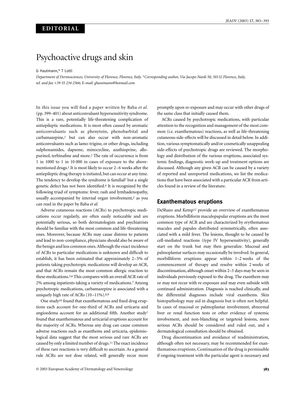Psychoactive Drugs and Skin
June 2003
in “
Journal of the European Academy of Dermatology and Venereology
”
carbamazepine erythema multiforme Stevens-Johnson syndrome toxic epidermal necrolysis hypersensitivity vasculitis erythroderma drug-induced lupus erythematosus anticonvulsant hypersensitivity syndrome drug-induced alopecia photosensitivity reactions lithium psychotropic drugs hair loss skin pigmentation issues hair loss skin pigmentation issues

TLDR Some psychoactive drugs can cause skin reactions, with carbamazepine having a higher risk, and stopping the drug and seeing a dermatologist is important.
The document from 2003 highlights the range of adverse cutaneous reactions (ACRs) associated with psychoactive drugs, which can affect 2-5% of patients, with carbamazepine showing a higher rate of ACRs at 10-11%. It discusses various ACRs, including common exanthematous eruptions, serious conditions like erythema multiforme, Stevens-Johnson syndrome, and toxic epidermal necrolysis, as well as hypersensitivity vasculitis, erythroderma, drug-induced lupus erythematosus, and anticonvulsant hypersensitivity syndrome. Drug-induced alopecia, pigment disorders, and photosensitivity reactions are also covered, with specific drugs linked to particular reactions, such as alopecia with lithium. The importance of drug discontinuation and dermatological consultation for diagnosis and management is emphasized, and healthcare professionals are urged to educate patients about the risks of serious drug reactions. The document also notes that psychotropic drugs can cause hair loss, changes in hair color, and skin pigmentation issues.







